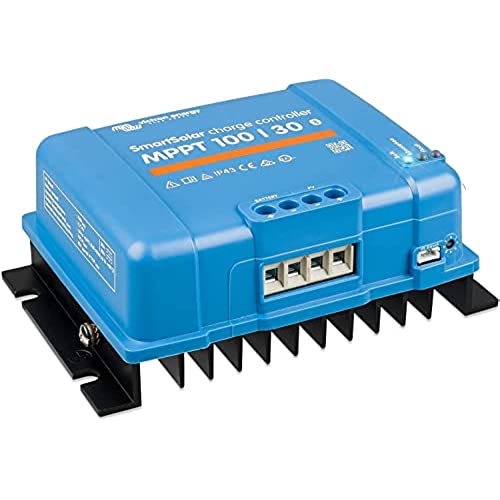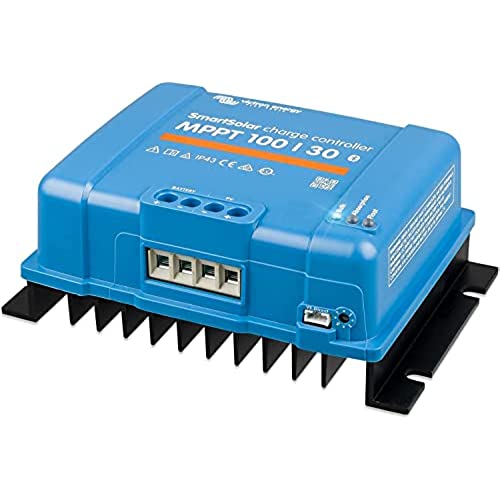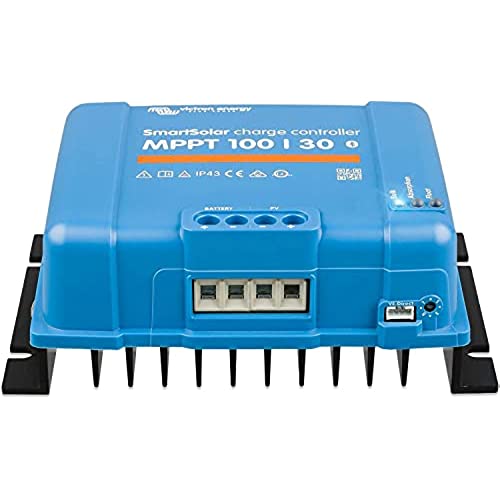









Victron Energy SmartSolar MPPT 100V 30 amp 12/24-Volt Solar Charge Controller (Bluetooth)
-

M. Dillon
> 3 dayThe 75-15 units work great and stay cool under full load. They work as advertised. That said, the 15A output limit doesnt give you much at 12V (200W) or 24V (400W) (my battery system is 24V LFP), and I made the mistake of undersizing the charge controller against my solar which runs 500W+ in full sun. Hence why I was able to make the comment about them staying cool under full load :-). So I recommend buying the SmartSolar MPPT 100-20 instead of the 75-15. The price point is still very good and those 5 extra amps can make a difference. Plus the 75-15 is limited to 24V battery systems while the 100-20 gives you the flexibility to move to a more powerful 48V battery system in the future. I also have two 100-20s. When maxed out at 20A they generally clock in at 60C and dont go much higher, so not as cool as the 75-15s. But the 100-20s are far more capable, and can handle 12/24/48V without issue. A low speed fan is all it takes to keep them in a nice comfort zone while pushing 20A to the battery. Im running 70V VOC and 80V VOC (roughly) strings with no issues into these controllers, so the input amps and losses are very low. Thus the charge controllers are limited only by the output amps. The control and programming features are great. Ive used the load output directly and the virtual load output (basically a relay control output) as well. There are a few quirks with the direct load output, it cant handle surges at all really, even short ones. The battery profile is completely customizable and output amps can be limited. I actually used one of my 75-15 charge controllers as a high-efficiency level shifter going from a 24V battery to a small 12V battery at one point using the customization to limit the current. -- It would be nice if the load output could handle more current and capacitive inflow currents on start. I have used the load output on 24V systems at around 15A without issue driving resistive loads. But just like the Victron battery-protect stuff, these FET-switched load outputs cheap-out on components and just arent very capable despite the rating. It would be nice if Victron could improve on them but I wont subtract a star since it isnt really the primary function for the charge controller and the virtual-load output works quite well. In fact, one can use the actual load output to switch certain other FET power switches, (or relays, or contactors) very quickly since they are capable of decent gate currents verses VE TX port. So there is versatility here that I like.
-

Gary
> 3 dayWorked for a few days and I disconnected it to try a different solar panel and now VictronConnect can’t find my 100/30 at all. Tried all the suggestions on Victron’s site but still no luck. I’m going to try the Bluetooth dongle. If that doesn’t work then I give up and buy another brand. Update: The Bluetooth dongle worked. The 100/30 can now be seen as a devise in VictronConnect. I am upgrading my stars, but because of the extra cost for the dongle, I’m only adding two. I needed the Bluetooth to work in order to configure the charge controller correctly for lithium batteries. Update: An amazing thing has happened. After the 100/30 Bluetooth quit working, I contacted Victron and asked how to apply for warranty service. I was told to go thru Amazon, where I purchased it. Not really expecting much, I was very happy to receive a totally new 100/30 yesterday, 9/16/20. I have now installed it and it works perfectly. This changes everything! I’ve never had such excellent warranty response. Thanks very much. This earns full stars as well.
-

James Betts
> 3 dayLiked everything - ish it had a stronger bluetooth signal. Other victron units in same bay work great.
-

Repro63
> 3 dayI have built 3 so called Solar Generators, and have used Victron Energy charge controllers in all of them. I tried other brands, and always seemed to run into issues with configuration, ease of use and size. I have two 100/30 charge controllers and I love them both. They are small. very very efficient and they are so reliable. I love the Bluetooth connection and Victron Energys app. Configuration is a breeze, and I can even do a little logging of the chargers performance. This controller also has a very small footprint, and it fits into tight places. Installation is easy as well. These are little more expensive than other controllers, but they are worth it to me. They have never let me down, and they are very reliable. I find them to be a good value for the price and I highly recommend them. I give this controller 5 stars.
-

Anna S
19-04-2025Simple to install, easy to program, and awesome to keep tabs on your power in/out!
-

Valentyna
> 3 dayExcellent
-

Marcos Estebez
> 3 dayIve had Epever and Renogy controllers which were both difficult to read and configure for Lithium battery. Once I resigned myself to bluetooth - I loved it! The software offers a lot of programmable options which is important for LifeP04 battery (check out Battle Born batteries for info on how to configure). The bad: Victron says to use 10AWG wires. Good luck. It took a half hour to install two cables. You install. You damage the wires. You cut. You reinstall and on and on...By the time I got both in, the terminal box was trashed and the screws (pleeeeease, my daughters Barbies jeep has sturdier screws..and theyre plastic) the screws have a very shallow indentation for a flathead screw driver. After multiple attempts of tightening, one of them was stripped. Ive ordered a 100/30 in the hopes of actually being able to use 10AWG. (Victron says that model accommodates 6AWG but reviewers disagree......) Disappointed but hopeful. If you are going to use this, go with 12AWG.
-

caryprnt
> 3 dayVictron is great at making electronics for solar systems. Bluetooth always works
-

rick
> 3 dayFirst ten days of use were cloudy and rainy. Power from 200 watt panel was efficiently stored in 200 ah lipo battery pack.
-

kwerks
> 3 dayI really expected to like the Victron Smart Solar. I already own the 100/15 Blue Solar plus bluetooth dongle, and have good results with it. However, after struggling with the Smart Solar I was disappointed and returned it. In my view its a step backward from Blue Solar. If youre thinking of buying the 75/15 Smart Solar, you may want to reconsider and get the 75/15 Blue Solar and buy the external bluetooth dongle. There is really no benefit to the Smart Solar over the Blue Solar + BT dongle. You might save $10-$20, but you end up with an inferior product in many other respects. First, the integrated bluetooth range is much less than the BT dongle. Were talking 5 feet vs. 20 to 30. This also gets to the heart of my main gripe: Victrons choice of Bluetooth transceiver. Theyre using newer BLuetooth Low Energy technology (BLE) vs older but more widely supported BT 4.0, as used in the external dongle. In my view it wasnt a good move. BLE, is not supported by the majority of BT enabled devices. If you want to use iOS or Android, be aware that even if they have BT, they will likely NOT work with the Smart Solar bluetooth! Obviously this isnt a good selling point and Victron sales literature doesnt warn customers about this ahead of time. Youll end up downloading their app and get frustrated trying to connect to the controller, and eventually learn that your 1 year old device wont work with it. Nearly every device in the world with BT will work with BT 4.0, but Victron went with the BT low energy and gave up compatibility with the majority of the worlds devices. Was that a smart decision? Well they saved a few cents per controller, and I suppose low energy in theory saves some power. But, the charge controller is NOT lacking for power. Its either getting power from a PV array or a presumably large battery, not a tiny batteries where BLE might be useful. I would much rather have 20-30 foot range and use a few more micro watts of power than need to stand 5 feet from the controller. And youll find with Android, that BLE *requires* that you enable location/GPS for the Victron Connect app to work! No kidding. Victron says they dont care about your location, and probably dont. But youll need to accept that and enable location services to use their app with Smart Solar. With Blue Solar and the external dongle its not necessary. This is forced on everyone by Google/Android not Victron, but again, the choice of using BLE was Victrons. Finally, IMO the 100/15 is better constructed than the 75/15, albeit at a higher price. The 100/15 has an external heat sink and the 75/15 does not. That could be a benefit in a hot environment like the desert. You may want to take a look at it. The next step up is 100/20 which also has an external heat sink like the 100/15. All of these have separate load terminals which is really useful because the controllers have a configurable low voltage disconnect (via the app) and can also track how much power the load is actually using. When you get over 20 amps, for example 100/30 amp controllers and up, they do not have separate load terminals. Update: I measured the current draw of a Blue Solar 100/15 and Smart Solar 100/20. Connected to battery at 12.8v. No PV or load connected, and not connected to app via BT. Blue Solar 100/15: 24 mA. With BT dongle 25.5-26 mA Smart Solar 100/20: 34 mA. With BT dongle 35-36.5 mA I dont have numbers for the 75/15, though its likely not more than above. The point is, the BT 4.x dongle takes only 1 to 1.5 mA. Unless youre using a 15 amp MPPT controller with a battery bank the size of a coin cell battery, the BT dongle is the way to go (IMO).
